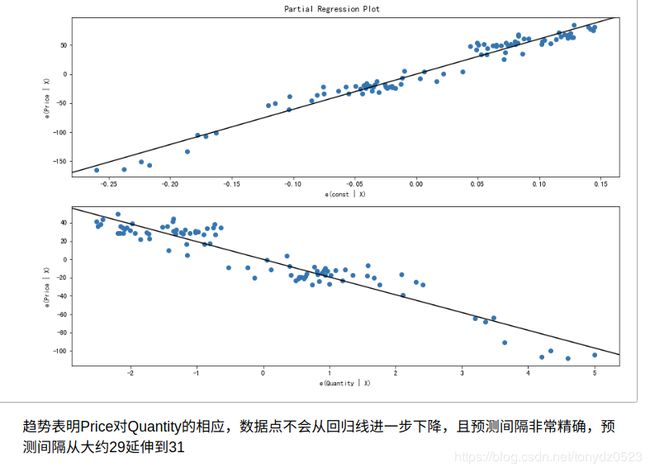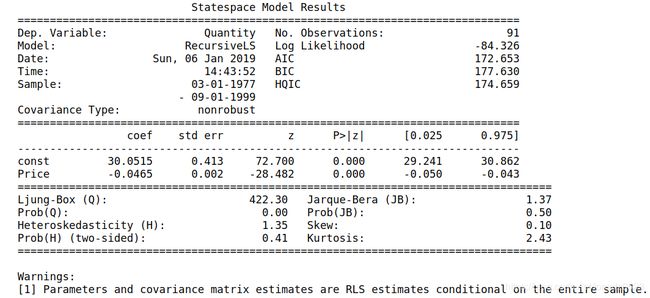python数据分析:使用statsmodels构建价格需求弹性模型
价格需求弹性(Price elasticity of demand)
是经济学中使用的一种衡量标准,用于显示商品或服务所需数量对价格变化的响应性或弹性,除了价格变化。更确切地说,它给出了响应价格百分之一变化所需数量的百分比变化。
在经济学中,弹性是衡量需求或供给对价格敏感程度的指标。
在营销中,消费者对产品价格变化的敏感程度如何。
它给出了以下问题的答案:
- “如果我降低产品的价格,还会卖多少钱?”
- “如果我提高一种产品的价格,这将如何影响其他产品的销售?”
- “如果产品的市场价格下降,那将影响公司愿意向市场供应的金额多少?”
数据
一份关于牛肉价格数量随时间变化的数据
数据描述
- Year:年份
- Quarter:季度
- Quantity:数量
- Price:价格
python实践
1.导入库 和 数据
import numpy as np
import pandas as pd
import matplotlib.pyplot as plt
import statsmodels.api as sm
from statsmodels.formula.api import ols
from statsmodels.compat import lzip
from __future__ import print_function
%matplotlib inline
df = pd.read_csv('https://raw.githubusercontent.com/ffzs/dataset/master/beef.csv')
df.head()
2.查看缺失值
# 检查缺失值,没有
df.isnull().values.any()
False
3.合并年和季度数据
# 年和季度合并
df['Year'] = pd.to_datetime(df['Year'], format="%Y")
from pandas.tseries.offsets import *
df['Date'] = df.apply(lambda x:(x['Year'] + BQuarterBegin(x['Quarter'])), axis=1)
df.drop(['Year', 'Quarter'], axis=1, inplace=True)
df.set_index('Date', inplace=True)
4.数据简单观察
# 简单观察数量和价格跟随时间的变化
df.plot.line(subplots=True)
# 通过散点图简单看一下数量和价格之间的关系成负相关
df.plot.scatter(x='Quantity', y='Price', c='g', s=18)
回归分析
最小二乘法(Ordinary Least Squares)估计
# 获取自变量和因变量
x = df.Quantity
y = df.Price
X = sm.add_constant(x)
ols_model = sm.OLS(y, X)
result = ols_model.fit()
print(result.summary2())
- P值很小说明价格和数量无关的null hypothesis被拒绝
- 高R平方值也说明了我们的模型预测很准
展示图表用于更直观的解释回归分析
# 调出y的拟合值
y_fit = result.fittedvalues
# 使用matplotlib画图
fig, ax= plt.subplots(figsize=(10,6))
# 画图原始数据
ax.plot(x, y ,'o', label='raw_data')
# 画出拟合后的数据
ax.plot(x, y_fit, 'r--.',label='OLS')
#放置注释
ax.legend(loc='best')
fig = plt.figure(figsize=(12,8))
fig = sm.graphics.plot_partregress_grid(result, fig=fig)
CCPP图
CCPR图提供了一种方法,通过考虑其他自变量的影响来判断一个回归量对响应变量的影响。
fig = plt.figure(figsize =(12,8))
fig = sm.graphics.plot_ccpr_grid(result,fig = fig)

正如您所看到的,由Price解释的数量变化之间的关系是明确的线性。没有太多的观察结果对这种关系产生了相当大的影响。
递归最小二乘(RLS)
最后,我们应用递归最小二乘(RLS)滤波器来研究参数不稳定性
endog = df['Quantity']
exog = sm.add_constant(df['Price'])
mod = sm.RecursiveLS(endog, exog)
res = mod.fit()
print(res.summary())
RLS图
我们可以在给定变量上生成递归估计系数图。
res.plot_recursive_coefficient(range(mod.k_exog), alpha=None, figsize=(10,6))
为方便起见,我们使用plot_cusum函数直观地检查参数稳定性。
fig = res.plot_cusum(figsize=(10,6))








